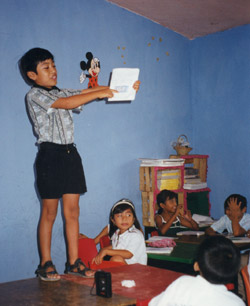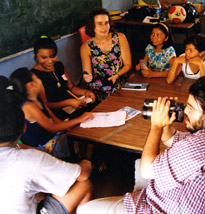|
Download the SELT Teaching English Service Learning Brochure
Read Student Evaluations and Comments from Previous Field Seasons
Teaching English Service Learning
OSEA has designed a special Service Learning program that provides hands-on, experiential learning on-site in a study abroad context. SELT Participants gain experience and training in three areas that are brought together in a concrete, practical application of learning that provides a tangible and positive service to the community. As a comprehensive service learning project, the SELF Participants are engaged in a dynamic form of Community Action Research that contributes directly and concretely to people's needs and well-being.
SELT Participants are Students
SELT Participants are students that are trained in Teaching English as a Second Language methods. Participants are students that are trained in ethnographic methods of participant observation, visual anthropology, and documentation. Participants are students that learn basic communicative skills of Maya language and learn about Maya culture in a community situated within 10 minutes walk of Chichén Itzá, World Heritage site and one of the Modern Seven Wonders of the World.
that are specially shaped for use as a part of a ethnographic research project.
SELT Participants are Teachers
Student participants are also teachers. Under the direction and close supervision of SELT Coordinator students combine these skill sets and knowledge by designing a program to teach English to children and adults in the Maya community of Pisté. The pedagogy is carefully crafted to forefront the use of Maya culture and language as the means by which to teach English.
SELT Participants are Ethnographers
Teacher participants are also ethnographers in three ways. First, as part of the educational process, the teacher-participants use ethnographic methods of participant observation, visual documentation, and fieldnotes to record the successes and achievements of the English language learners. Second, as well, the ethnographer-teachers maintain an ethnographic record of their own experiences learning about Maya culture and interacting with Maya people as this relates to the classroom process of teaching English. The ethnographer participants are both teachers and students, afterall! Third, the SELT participants as ethnographers are involved in the everyday life of the community studying the transcultural dynamics of interaction that they have created by teaching English as second language.
SELT Participants are Community Action Researchers
Ethnographer participants are therefore researchers deeply involved in an ongoing Community Action Research project. This project developed out of the economic need felt by the majority of community members to learn English as means for their social advancement. Click here for more details on the history of SELT.) Although English is almost everywhere viewed as an economic tool, it is especially viewed this way in Yucatan, where international tourism, especially from the USA, is one the top economic sectors of society. But, the Maya of Piste are not just interested in learning English for these reasons. As cultural descendents and heirs of the Maya civilization as as manifest in the nearby archaeological city of Chichen Itza, the community has been host to tourists and travelers for over a hundred years. They have established lasting personal connections with many visitors to their community and have a special regard for the US visitor and traveler who take the time to live and learn about the Maya and their vibrant community culture. The people of Piste, as the people of Yucatan, more generally, seek to foment further cross cultural exchanges and intercultural relationships. English is an important means for achieving these personal goals and cultural values. Your participation in the SELF Program is an important contribution to these goals, motivations, and needs. In turn, your participation will also be transformative and help you gain an increased transcultural understanding, important professional skills and training, along with a personally rich and rewarding experience.
_________________________________________________________________________________
SELT Service Learning Credits
SELT Participants gain 6 credits of service learning that can count toward your Major's requirements for fieldwork experience, field practicum, or research methods in content areas such as bilingual education, TESL, ethnography, anthropology, course design for second language acquisition, intercultural communications, and more. Please contact your program advisor early on to discuss how the credit transfers can count toward your degree and major requirements. Feel free to talk to us about your interests and questions about how the SELT coursework can best serve you and how to transfer credit.
The SELT program provides an accredited transcript of completed coursework from the Universidad Autonoma de Yucatan, in Merida, Yucatan. The courses are in Anthropology.
SELT Teaching English Coursework
The SELT program is primarily a hands-on, experiential learning course that includes both classroom contact hours and field practicum hours. Core Classroom Contact Hours include time with the OSEA staff to learn Maya, Maya culture, ethnography, and TESL methods. Classroom time in the initial part of the program is also devoted to designing the English as a second language course for children and adults. Practicum hours divide into time teaching English, which includes doing ethnographic observation of classes taught by other participants, and debriefing sessions with the staff on a periodic basis.
|







